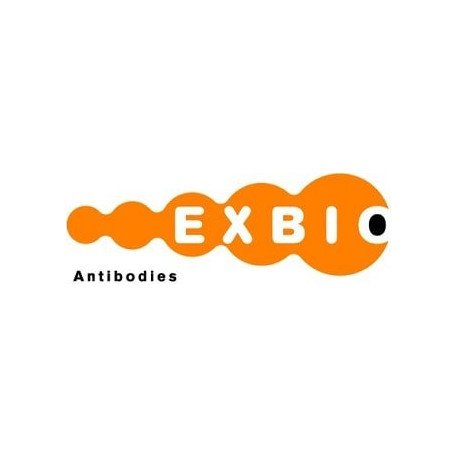Cart 0 Product Products (empty)
No products
To be determined Shipping
0,00 € Total
Prices are tax excluded
Product successfully added to your shopping cart
Quantity
Total
There are 0 items in your cart. There is 1 item in your cart.
Total products (tax excl.)
Total shipping (tax excl.) To be determined
Total (tax excl.)
 View larger
View larger Data sheet of Mouse Monoclonal to c-Myc / Cellular myelocytomatosis oncogene
| Brand | Exbio |
| Product type | Primary antibodies |
| Reactivity | Human, Recognizes fusion proteins in all species |
| Clonality | Monoclonal |
More info about Mouse Monoclonal to c-Myc / Cellular myelocytomatosis oncogene
| Brand: | Exbio |
| Product no.: | 11-433-C025 |
| Product type: | Primary antibodies |
| Host species: | Mouse |
| Product name: | Mouse Monoclonal to c-Myc / Cellular myelocytomatosis oncogene |
| Antigen: | c-Myc |
| Clonality: | Monoclonal |
| Clone: | 9E10 |
| Isotype: | IgG1 |
| Immunogen: | Synthetic peptide sequence (AEEQKLISEEDLL) corresponding to the C-terminal region of human c-Myc._x000D_ |
| Format: | purified |
| Specificity: | The antibody 9E10 can be used to detect the c-Myc tag. |
| Categories: | Epitope Tags |
| Concentration: | 1 mg/ml |
| Storage buffer: | Phosphate buffered saline (PBS) with 15 mM sodium azide, approx. pH 7.4 |
| Storage / stability: | Store at 2-8°C. Do not freeze. Do not use after expiration date stamped on vial label. |
| Background: | The c-myc gene (8q24 on human chromosome) is the cellular homologue of the v-myc gene originally isolated from an avian myelocytomatosis virus. The c-Myc protein is a transcription factor (nuclear localization). c-Myc is commonly activated in a variety of tumor cells and plays an important role in cellular proliferation, differentiation, apoptosis and cell cycle progression. The phosphorylation of c-Myc has been investigated and previous studies have suggested a functional association between phosphorylation at Thr58/Ser62 by glycogen synthase kinase 3, cyclin-dependent kinase, ERK2 and C-Jun N-terminal Kinase (JNK) in cell proliferation and cell cycle regulation. In normal cells the expression of c-Myc is tightly regulated but in human cancers c-Myc is frequently deregulated. c-Myc is also essential for tumor cell development in vasculogenesis and angiogenesis that distribute blood throughout the cells. |
| Purity: | > 95% (by SDS-PAGE) |
| Purification: | Purified by protein-A affinity chromatography |
| Product specific references: | *JelÃnková I, Å afaÅ™Ãková B, Vondálová Blanářová O, Skender B, Hofmanová J, Sova P, Moyer MP, KozubÃk A, Kolář Z, Ehrmann J, HyrÅ¡lová Vaculová A: Biochem Pharmacol. 2014 Dec 1;92(3):415-24., *Cermák L, SÃmová S, Pintzas A, Horejsà V, Andera L: Molecular mechanisms involved in CD43-mediated apoptosis of TF-1 cells. Roles of transcription Daxx expression, and adhesion molecules. J Biol Chem. 2002 Mar 8;277(10):7955-61., * Hilpert K, Hansen G, Wessner H, Kuttner G, Welfle K, Seifert M, Hohne W: Anti-c-myc antibody 9E10: epitope key positions and variability characterized using peptide spot synthesis on cellulose. Protein Eng. 2001 Oct;14(10):803-6. , *Veracini L, Simon V, Richard V, Schraven B, Horejsi V, Roche S, Benistant C: The Csk-binding protein PAG regulates PDGF-induced Src mitogenic signaling via GM1. J Cell Biol. 2008 Aug 11;182(3):603-14., *Siegel J, Brandner G, Hess RD: Cross-reactivity of the monoclonal antibody 9E10 with murine c-MYC. Int J Oncol. 1998 Dec;13(6):1259-62. , *Wang X, Campoli M, Ko E, Luo W, Ferrone S: Enhancement of scFv fragment reactivity with target antigens in binding assays following mixing with anti-tag monoclonal antibodies._x000D_ J Immunol Methods. 2004 Nov;294(1-2):23-35. , *Fujiwara K, Poikonen K, Aleman L, Valtavaara M, Saksela K, Mayer BJ: A single-chain antibody/epitope system for functional analysis of protein-protein interactions. Biochemistry. 2002 Oct 22;41(42):12729-38. , *Baggio R, Burgstaller P, Hale SP, Putney AR, Lane M, Lipovsek D, Wright MC, Roberts RW, Liu R, Szostak JW, Wagner RW: Identification of epitope-like consensus motifs using mRNA display. J Mol Recognit. 2002 May-Jun;15(3):126-34. |
| General references: | Spandidos DA et al. 1987. Elevated expression of the myc gene in human benign and malignant breast lesions compared to normal tissue. Anticancer Res 7:1299-304., Persson H, Hennighausen L, Taub R, DeGrado W, Leder P: Antibodies to human c-myc oncogene product: evidence of an evolutionarily conserved protein induced during cell proliferation. Science. 1984 Aug 17;225(4663):687-93. _x000D_ , Evan GI et al. 1985. Isolation of monoclonal antibodies specific for human c-myc proto-oncogene product. Mol Cell Biol 5:3610-6., Prendergast GC. 1999. Mechanisms of apoptosis by c-Myc. Oncogene 18(19):2967-2987., Dang CV, Resar LM, Emison E, Kim S, Li Q, Prescott JE, Wonsey D, Zeller K. 1999. Function of the c-Myc oncogenic transcription factor. Exp Cell Res 253(1): 63-77., Boxer LM, Dang CV. 2001. Translocations involving c-myc and c-myc function. Oncogene 20(40):5595-5610., Hoffman B, Amanullah A, Shafarenko M, Liebermann DA. 2002. The proto-oncogene c-myc in hematopoietic development and leukemogenesis. Oncogene 21(21): 3414-3421. |
| Related products: | - Mouse Monoclonal to CRP - Mouse Monoclonal to C-peptide - Mouse Monoclonal to CPNE7 |
| Shipping condition: | Room temperature |

